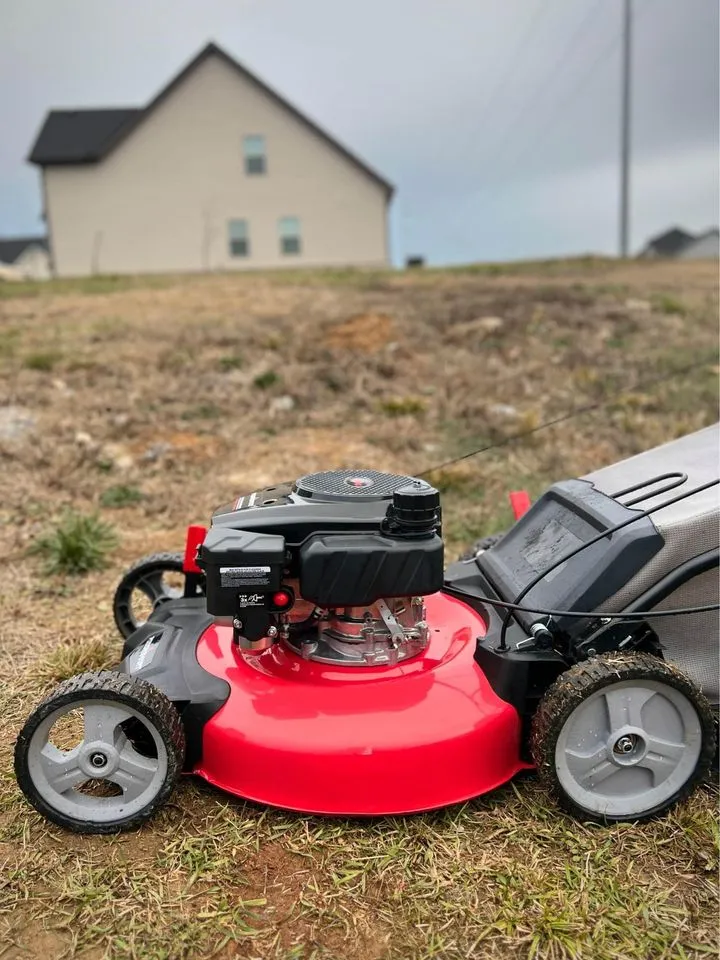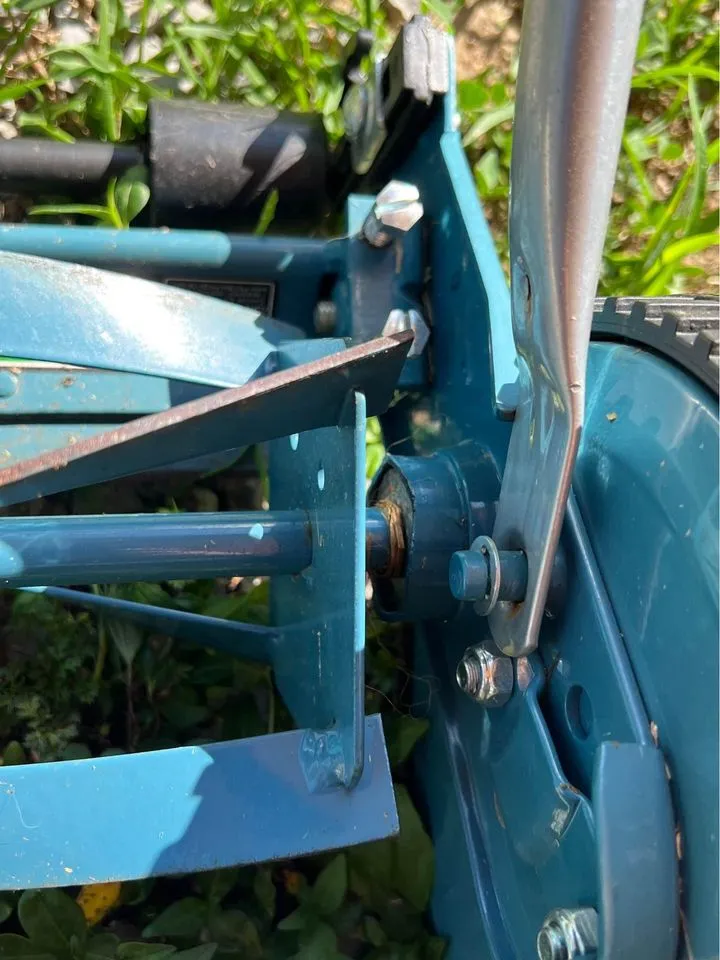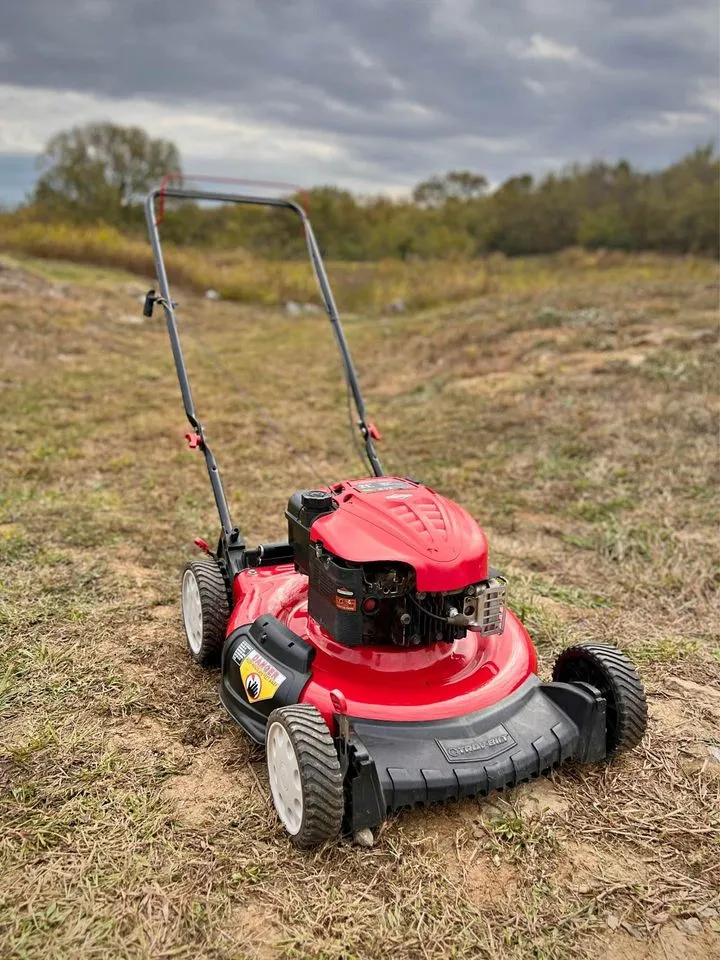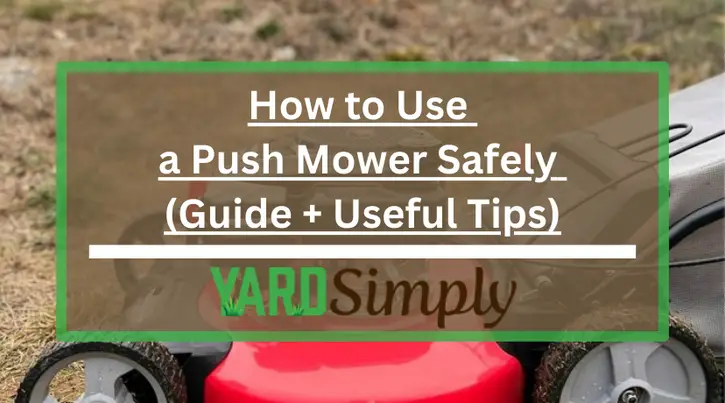Welcome to our comprehensive guide on how to use a push mower. As an experienced landscaping professional with over a decade in the field, I bring a wealth of hands-on knowledge to this topic.
My aim is to provide you with clear, concise instructions that will not only make mowing your lawn more efficient but also more enjoyable.
Drawing from years of practical experience and technical expertise, I assure you that the insights shared here are reliable and tailored to enhance your mowing skills.
So, whether you’re a beginner or looking to refine your technique, let’s dive into the essentials of using a push mower effectively, ensuring that every word here empowers you to achieve a perfectly manicured lawn.
Quick Summary
- To use a push mower effectively, start with safety checks, adjust the mower’s height according to grass length, mow in straight lines or patterns, and perform regular maintenance for optimal performance.
- Regular maintenance, such as blade sharpening and mower storage, is crucial for the longevity and efficiency of push mowers.
- Homeowners who regularly use push mowers spend approximately 30% more time on lawn care, often resulting in higher satisfaction with lawn appearance.
- Personally, I find the use of a push mower not only environmentally friendly but also immensely satisfying for its hands-on approach and the immediate visual improvement it brings to the lawn.
Using a Push Mower
- Safety First: Wear appropriate clothing and footwear to protect yourself. Avoid loose clothing.
- Inspect the Mower: Before starting, check your push mower for any visible damage, ensure the blades are sharp, and that all nuts and bolts are tightened.
- Check the Lawn: Remove any debris, stones, or sticks from the lawn. These can be hazardous when mowing.
- Set the Mower Height: Adjust the cutting height according to the length of your grass. Generally, it’s recommended not to cut more than one-third of the grass blade length at a time.
- Fill with Fuel (if applicable): If your push mower is gas-powered, fill it with the correct type of fuel. Do this in a well-ventilated area.
- Prime the Engine (if applicable): If your mower has a primer bulb, press it 3-4 times to draw fuel into the carburetor.
- Start the Mower: For a gas mower, pull the starter rope sharply. For a manual reel mower, just start pushing.
- Mow in Rows or Patterns: Begin mowing in straight lines, overlapping each row slightly. You can choose a pattern that suits your lawn shape.
- Turn the Mower Safely: At the end of a row, lift the front wheels slightly to turn the mower around for the next row.
- Empty the Bag Regularly (if attached): If your mower collects grass clippings, empty the bag when it’s about three-quarters full.
- Take Breaks: Push mowing can be physically demanding, so take breaks as needed, especially in hot weather.
- Clean the Mower After Use: Remove grass clippings from the mower. Store it in a dry, safe place.
- Maintenance: Regularly check the mower for wear and tear, sharpen the blades, and change the oil (if it’s a gas mower).
Starting the Mower

Before we get our hands dirty, let’s make sure we know how to kickstart the process.
I’ll walk you through the necessary steps to get your push mower purring.
First up, we’ll go over the simple yet crucial procedures to start your mower with ease.
Step-by-Step Instructions on Starting the Mower
Safety Checks Before Starting Any Mower
- Conduct a pre-use inspection by consulting the mower’s manual for specific maintenance tips.
- Confirm the correct fuel type is being used.
- Wear appropriate personal protective gear to ensure safety.
- Plan for the environmentally friendly disposal of grass clippings.
Steps for Different Mower Types
Manual Push Reel Mowers
- Periodically sharpen the blades for a smooth operation.
- Check for any loose parts or damage before use.
Gas-Powered Rotary Mowers
- Inspect and top up the oil as necessary.
- Pull the starter cord to ignite the engine.
Electric Mowers
- Ensure the mower is connected to a power source or the battery is fully charged.
- Simply press the start button to activate.
Post-Start Checks
- Adhere to a regular maintenance schedule.
- Manage grass clippings effectively.
- Utilize ergonomic handles for comfortable use.
- Store your mower in a clean, dry place.
Related: How to Start a Push Mower
Troubleshooting Common Starting Issues
For All Mower Types
- Check for stale fuel or improper fuel levels.
- Inspect the spark plug for signs of corrosion or poor connection.
- Examine the air filter for clogs.
Specifically for Gas-Powered Mowers
- Clean the carburetor if needed.
- Make sure the choke function is correctly set for an easier start.
Enhancing Mowing Techniques for Optimal Lawn Care
Perfecting your mowing technique is not just about lawn maintenance; it’s a blend of art and science that benefits both the health of your lawn and your personal well-being.
Adapting to Terrain
- On flat landscapes, I use straightforward, efficient strokes.
- For hilly terrains, I adjust my approach to ensure even cutting and minimal strain.
- Whether it’s a gentle slope or an uneven patch, my techniques are tweaked for best results.
Mowing Patterns
- I favor straight lines or overlapping rows for a uniform look.
- For a touch of elegance, diagonal patterns create striking grass stripes.
- Rotating mowing patterns helps in preventing soil compaction and promotes healthier grass growth.
Best Practices for Mowing
- Maintain an upright posture with slightly bent arms for comfort and efficiency.
- Match your mowing speed to the terrain and grass length for an even cut.
- Regular mower maintenance is key to a smooth mowing experience.
- Efficient grass clipping disposal ensures a neat lawn and a healthy ecosystem.
- Staying hydrated and fit is essential for endurance during longer mowing sessions.
Tailoring Techniques for Different Lawn Types
- Select grass varieties that thrive in your lawn’s specific conditions.
- Regularly maintain your mower for precision and ease of use.
- Meticulous soil preparation and a well-planned fertilization schedule fortify your lawn against the demands of mowing.
Efficiency Tips
Maximizing Mowing Efficiency for Perfect Lawns
Efficiency in mowing is crucial, whether you’re dealing with an expansive lawn or a smaller patch. By adapting your approach to the lawn’s size, weather conditions, and grass type, you can significantly enhance the quality of your work.
Here’s how I optimize my mowing routine:
Strategies for Different Lawn Sizes
- For Large Lawns:
- Use efficient patterns to cover more area with less overlap.
- Regular blade sharpening keeps the mower cutting smoothly.
- Grass cycling nourishes the lawn and reduces waste.
- Edging defines the area and adds a neat finish.
- For Small Lawns:
- Focus on precise mowing to avoid redundant passes.
- Clipping disposal through composting is ideal.
- Adjust mowing frequency based on lawn usage and growth rate.
Adapting to Weather and Grass Types
- Weather Considerations:
- Adjust mowing schedules based on grass hydration levels.
- Adapt to changing weather patterns for optimal grass health.
- Grass Type Specifics:
- Understand the specific needs of your grass type, adjusting mowing height and frequency accordingly.
- Be mindful of the sun and shade patterns that affect grass growth and resilience.
Related Articles:
- Best Lawn Mowers for Zoysia Grass
- Best Lawn Mowers for St. Augustine Grass
- Best Lawn Mowers for Bermuda Grass
Adjusting the Mower
Adapting the mower to different challenges is crucial for maintaining a healthy lawn and an effective mowing session.
Blade Height Adjustment – Optimizing Blade Height for a Healthier Lawn

Adjusting the blade height on your push mower is a key factor in achieving a lush, attractive lawn. It’s not just about aesthetics; the right blade height promotes healthy grass growth and ensures a uniform cut.
Here’s how I go about setting the ideal height for my lawn:
Determining the Right Cutting Height
- Evaluate Grass Species:
- Different grass types thrive at different heights. Research your lawn’s grass species to find the recommended mowing height.
- Consider Seasonal Changes:
- Grass growth patterns change with the seasons, so adjust the blade height accordingly. For example, a higher cut in summer can protect against heat stress.
- Assess Environmental Factors:
- The moisture level of your lawn and soil type can influence the ideal cutting height. For instance, drier conditions might require a higher cut to preserve grass health.
- If you prefer mulching, a slightly higher cut ensures better decomposition of the clippings back into the soil.
Step-by-Step Guide to Adjusting Blade Height
- Safety First:
- Ensure the mower is turned off.
- Disconnect the spark plug to prevent accidental starts.
- Locate the Height Adjustment Mechanism:
- Most push mowers have a lever or knob near the wheels.
- Adjust the Height:
- Set the mower to the desired height. Make sure it’s even across all wheels for a uniform cut.
- Check Regularly:
- Continually monitor and adjust the blade height throughout the mowing season to align with your lawn’s needs and growth patterns.
Handling Different Mowing Challenges
Facing tough mowing challenges, like dense grass or unexpected obstacles, I’ve found that fine-tuning my push mower’s settings is crucial.
Let me guide you through the adjustment techniques that make these tasks effortless.
Whether you’re maneuvering around rocks or cutting through thick grass, the correct mower settings guarantee a perfect trim every time.
Here’s how to adjust your push mower for optimal performance in overgrown grass or around obstacles:
- Dealing with Grass Clumping:
- Increase deck height to reduce resistance
- Slow down the mowing pace to avoid blockages
- Wheel Maintenance and Discharge Direction:
- Consistently inspect wheels for fluid movement
- Direct discharge away from walkways
Practical Tips and Tricks
Now that we’ve tackled how to adjust your push mower, I’ll share some handy tips and tricks that have made my mowing much smoother.
Additional Tips for Easier and More Effective Mowing
To maximize your push mower’s efficiency, it’s essential to keep its blades sharp and well-maintained.
- Mower maintenance
- Sharpening blades: I sharpen them at least once a season to make cutting grass easier.
- Mower storage: I always clean the underside to remove grass clippings and store the mower in a dry place to prevent rust.
How to Deal with Common Challenges While Mowing
For clipping disposal, I use a mulching blade to finely chop the clippings and return nutrients to the soil. This also saves time on clean-up.
For fuel efficiency, I keep the mower’s engine tuned and the blades sharp, which reduces the effort needed to push and therefore the fuel consumption.
Noise reduction is another common issue; I’ve found that proper mower maintenance, including lubrication, makes a quieter and smoother mowing experience.
Regular maintenance also extends the life of my push mower, ensuring it runs effectively every time.
Maintenance and Storage Tips
Proper maintenance and storage of push mowers are crucial for their longevity and efficiency.
The frequency of blade sharpening varies with the type of mower; for example, new push-reel mowers may only require sharpening every three years, while gas or battery-powered mowers typically need it twice a season.
Additionally, the way you store your mower can significantly impact its lifespan. Storing it in a dry place, preferably hanging on a wall if space is limited, helps prevent rust and other damage.
Regular maintenance, including cleaning, lubrication, and proper fuel treatment, ensures the mower remains in optimal condition.
Cutting Techniques for Different Grass Types
Different grass types require specific mowing techniques to achieve optimal health and appearance. Thin and fine grass, often found in well-maintained lawns, is best cut with a manual reel mower.
These mowers offer a clean and precise cut, enhancing the lawn’s neatness. For thicker and denser grass, a gas-powered push mower is more suitable due to its higher power and cutting capability.
Adjusting the mowing technique according to the grass type ensures a well-manicured lawn and promotes the grass’s healthy growth.
Environmental Impact of Different Mower Types
An important consideration in lawn care is the environmental impact of different types of push mowers. Manual reel mowers stand out as the most eco-friendly option.
They operate without fuel or electricity, thus eliminating emissions and reducing your carbon footprint.
On the other hand, modern gas-powered mowers have significantly improved in terms of fuel efficiency and emissions compared to older models.
They now release 70 percent fewer emissions, making them a more environmentally conscious choice than their predecessors. By choosing the right mower type, you maintain your lawn and contribute positively to environmental sustainability.
Mower Maneuverability and Handling Challenges

The ease of maneuvering different push mowers varies greatly depending on the mower type and lawn terrain.
Manual reel mowers are lightweight and easy to handle on small, flat lawns but can be cumbersome on uneven or hilly terrain due to the physical strength required.
In contrast, gas-powered mowers, while more powerful and better suited for thick grass and sloped areas, can be heavier and more challenging to maneuver.
Understanding these nuances helps in selecting a mower that not only suits your lawn’s characteristics but also your ability to handle the equipment effectively.
Safety and Health Considerations
Adhering to safety protocols and considering health benefits are essential when using push mowers. Wearing protective footwear and eye protection is advisable to prevent injury from flying debris.
Manual mowing, particularly with reel mowers, can be a significant physical workout, providing health benefits similar to moderate outdoor exercise. This not only aids in maintaining your lawn but also contributes to your physical well-being.
Remember to stay hydrated and use sunscreen during prolonged mowing sessions, and consider ear protection for noise reduction, especially with gas-powered models. These practices ensure a safe and health-conscious mowing experience.
Our Verdict
In wrapping up, I’d like to share my personal verdict on using a quality push mower on large yards. From my experience, it’s not just a chore, but a rewarding exercise that contributes to both the beauty of my lawn and my physical well-being.
The satisfaction of seeing immediate results after mowing with the right techniques and settings is unparalleled.
Over the years, adapting to different grass types and terrains, while ensuring regular maintenance, has made lawn care an enjoyable part of my routine.
So, whether you’re a seasoned gardener or a newbie, a push mower can be a great ally in creating that perfect outdoor space. Remember, it’s not just about cutting grass; it’s about crafting a green, healthy, and beautiful environment right outside your door.
Frequently Asked Questions
Can a push mower be used on all types of grass, or are there certain varieties it’s not suitable for?
I’m not sure if every grass type is ideal for a push mower due to varying grass heights, terrain suitability, mower types, cutting techniques, and maintenance frequency needed for optimal performance.
How often should the blades on a push mower be sharpened for optimal performance?
I’d recommend sharpening the blades biannually for peak cutting efficiency. The blade material matters, so follow maintenance tips or opt for professional sharpening to ensure you’re not dulling them too quickly.
What are the environmental impacts of using a push mower compared to electric or gas-powered mowers?
I’m considering manual benefits like noise reduction, energy efficiency, and zero emissions. Push mowers are wildlife friendly, offering an eco-conscious choice compared to their electric or gas-powered counterparts.
Are there any specific safety gear or protective clothing recommended when using a push mower?
When tackling yard work, I always wear protective footwear and eye protection. It’s essential to protect my hearing, so I use earplugs, and I don’t forget sunscreen and hand gloves for added safety.
How should a push mower be stored during the off-season to ensure its longevity and readiness for the next use?
I’ll store it in a dry location, use moisture control measures, treat the fuel, check for proper lubrication, and take steps for pest prevention to keep it in top shape for next season.


